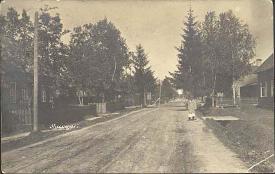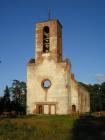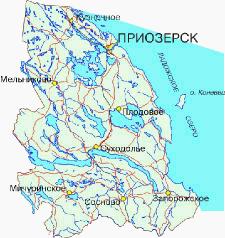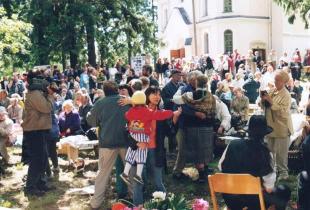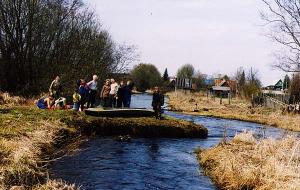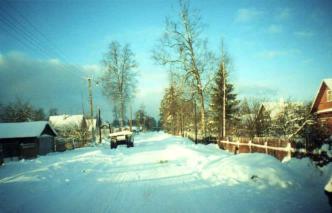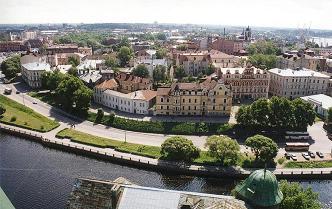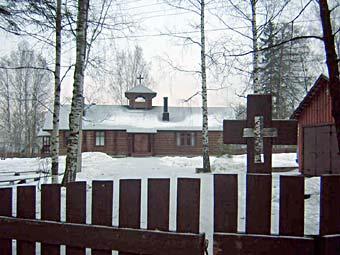Articles
/
Evangelical-Lutheran Church of Ingria
Evangelical-Lutheran Church of Ingria
Subject /
Religion. Church
Evangelical-Lutheran Church of Ingria (ЕLC of Ingeia). Oganizing of ЕLC of Ingria began when Russia surrendered the South shore of the Gulf of Finland and the Karelian Isthmus to Sweden according to the Treaty of Stolbovo in 1617 (Ingermanlandia, Izhora Land). 58 parishes, 36 churches and 42 pastors were in Ingria in 1655. Parishes were subordinated to the Narva Consistory. From 1721 the ecclesiastical guverning passed to the Holy Synod after the return of these lands to Russia in the early 18th century . When Finland was included in Russia (1809), the post of the head of ELC of Ingria was approved in the Consistory of St Petersburg in 1820. Bishop Sakari Syugneus was the first head of ELC of Ingria. From the 1870s the Finnish Sunday Schools began to expand (in the 1910s more than 570 schools with 16,000 pupils worked); Finnish library net began to work in the Gubernia of St Petersburg , partly under churches (22 libraries worked in the late 19th cent.). In 1863–1919 the Teacher -Kuester Seminary worked in Maly Kolpany. In 1914 in Ingria 29 village parishes and 4 town parishes worked (largest parishes were: St Mary in SPb – 16,000 parishioners, Slavyanka – 12,000 parishioners, Toksovo – 10,800 parishioners, Skvoritsy–Ropsha – 9,700 parishioners). In 1917 there are 141,330 parishioners in 25 main parishes of Ingria; 30 pastors and assistants worked in parishes. In 1919 the Committee of the Finland-Ingermanlandia was organized, In 1921 the Finland Consistory was formed (the Supreme Ecclesiastical Council; S.-Y. Laurikkala was a chairman in 1923-1937). In 1929-1930 closing of churches and repressions against clergy were began. 25 churches were closed in 1935-1939 (the last closed church was the church of the parish of Haapakangas near the village of Yukki). 40,000-60,000 Ingermanlandia people were repressed in the 1930s, about 45,000 men were deported in 1941-1942. Again the Finn community was formed in Petrozavodsk in 1964, it was registered in 1970; in 1975 the community was illegally formed in Koltushi, in 1977 the church was opened in Pushkin. In 1990 the Ingermanlandia Prostei was formed under the Estonia Archbishop. In 1993 ELC of Ingria was registered. Archbishop heads ELC of Ingria, the Church Council and the Church administration work under the Archbishop. 16 parishes ( including 11 parishes in the Leningrad Oblast) were in ELC of Ingria in the beginning of the 1990s, 72 parished were in 2003. 15,000 members were registered in ELC of Ingria. The Bishop Church (from 2002) is the Church of St Mary in St Petersburg. The Theological Institute is situated in the village of Kolbino ( the Vsevolozhsky District).
Authors
Shkarovsky, Mikhail Vitalyevich
Persons
Laurikalla, Selim Yalmari
Sugneus (Signeus), Sakari, bishop
Geography
Historical Toponyms/Ingermanlandia (Ingria)
Historical Toponyms/Izhora Land
Leningrad Oblast, the/Vsevolozhsk District/Kolbino Village (Kubensky Village Soviet)
Leningrad Oblast, the/Vsevolozhsk District/Koltushi Village
Leningrad Oblast, the/Gatchina District/Maliye Kolpani Village
Neighbouring Territories/Petrozavodsk City
Leningrad Oblast, the/Gatchina District/Skvoritsi Village
Leningrad Oblast, the/Vsevolozhsk District/Toksovo Urban Settlement
Leningrad Oblast, the/Vsevolozhsk District/Yukki Village
Bibliography
Князева Е.Е., Соловьева Г.Ф. Лютеранские церкви и приходы в России XVIII-XX вв. Ч. 1. СПб., 2001.
Шкаровский М., Черепенина Н. История Евангелическо-лютеранской церкви на Северо-Западе России. 1917-1945. СПб., 2004
Haltsonen S., Inkerin suomalaisten historia. Helsinki, 1969
Luther G. Herdaminke for Ingermanland. Helsingfors, 2000
Subject Index
Kolpany Teacher-Kuester Seminary
Theology Institute of the Evangelical-Lutheran Church of Ingria named after S.-Y. Laurikaly
Mentioned in articles:
|
hidden
|
"Inkerin Liito", a Finnish Public Society
"Inkerin Lito" ("Ingermanlandsky soyuz" ("Ingermanlandian Union") is a society of Finns of Ingermanlandia. It was organized in 1988 (the constituent assembly was in Taytsi Urban Settlement) and registered in 1989. In S.Petersburg and the Leningrad... more
|
|
|
|
hidden
|
Kingisepp District
KINGISEPP DISTRICT, a part of Leningrad Oblast. Population: 74,300, of which, 52,100 live in the adm. center Kingisepp Town. Area: 2842.1 sq. km. It has 191 rural settlements. It was established in 1927.It borders with Lomonosov, Volosovo, and... more
|
|
|
|
hidden
|
Kingisepp, town
KINGISEPP, town, adm. center of Kingisepp District. Population: 50,300. It situated on the banks of the Luga River, at the St. Petersburg-Tallinn highway and the St. Petersburg-Ivangorod-Tallinn railroad. The municipal entity Kingisepp Urban... more
|
|
|
|
hidden
|
Lomonosov District
LOMONOSOV DISTRICT. Area: 1990.8 sq. km. Population: 65,300. Established in 1927. L. D. comprises Bolshaya Izhora and Lebyazhye urban settlements and 140 rural localities. It borders St. Petersburg and Kingisepp, Volosovo, and Gatchina Districts of... more
|
|
|
|
hidden
|
Pobeda, settlement
POBEDA (Finnish Kanneljarvi before 1948), a settlement in Vyborg District. Population: 1900. Located on the shore of Lake Pobednoye (former Kanneljarvi, from the name of the musical instrument kantele, which the lake resembles in its shape.) Located... more
|
|
|
|
hidden
|
Priozersk District
PRIOZERSK DISTRICT, municipal entity. Population: 63,300 (of these, 20,500 live in Priozersk town, the adm. center.) Area: 3,563.1 sq. km. Located in the eastern and north-eastern parts of the Karelian Isthmus. It borders Vsevolozhsk and Vyborg... more
|
|
|
|
hidden
|
Uhannus, a festival
UHANNUS, festivity. This festivity is well known among the Finns from pre-Christian times, it was celebrated on the day of Summer Solstice (the Day of Ivan – Finnish Uhannus). The Luthran church celebrates Uhannus on June 24th (public street... more
|
|
|
|
hidden
|
Volosovo District
VOLOSOVO DISTRICT, a part of Leningrad Oblast. Area: 2680.5 sq. km. Population: 46,900. Adm. center: Volosovo Town. The district comprises Kikerino urban settlement, and 202 rural localities. It borders Kingisepp, Lomonosov, Gatchina, and Luga... more
|
|
|
|
hidden
|
Volosovo, town
VOLOSOVO, a town in Volosovo District and its adm. center. Population: 11,700. It is located on the Izhora Hills, at a station of the same name of the Gatchina–Ivangorod railway branch. The toponym V. is related to the name of the Slav pagan god... more
|
|
|
|
hidden
|
Vsevolozhsk District
VSEVOLOZHSK DISTRICT, a part of Leningrad Oblast. Area: 2945.4 sq. km. Population: 215,200. Adm. center: Vsevolozhsk Town. Comprises Sertolovo Town, six urban settlements (Dubrovka, settlement named after Morozov, settlement named after Sverdlov,... more
|
|
|
|
hidden
|
Vyborg District
VYBORG DISTRICT, municipal entity. Population: 172,800. Area: 7381.7 sq. km. V. D. comprises the towns of Vyborg (adm. center), Primorsk, Vysotsk, Kamennogorsk, Svetogorsk; urban settlements of Roschino, Lesogorsky, and Sovetsky; and 180 rural... more
|
|
|
|
hidden
|
Vyborg, town
VYBORG (Swedish Wiborg; Finnish Viipuri, until 1948), town, adm. center of Vyborg District. Population: 79,200. The toponym Vyborg originates from the Old Norse Wiborg = “sacred fortress.” It was founded in 1293 at the place of the Vuoksa River’s... more
|
|
|
|
hidden
|
Yukki, village
YUKKI (Finnish Haapakangas = “Aspen Sands”), a village in Vsevolozhsk District, near the St. Petersburg border. Population: 793 (prior to deportation in 1942 it was mostly inhabited by Ingermanlandian Finns.) Located at Lake Tohkolodskoye on kame... more
|
|
|
|






